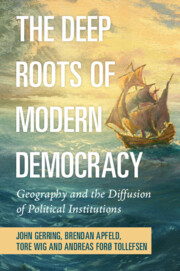Book contents
- The Deep Roots of Modern Democracy
- The Deep Roots of Modern Democracy
- Copyright page
- Dedication
- Contents
- Detailed Contents
- Figures
- Maps
- Tables
- Acknowledgments
- I Introduction
- II Maritime Geography
- III European Diffusion
- IV Alternate Explanations
- 12 Modalities of Geography
- 13 Modalities of European Diffusion
- 14 Economics, Institutions, Culture
- V Conclusions
- Appendix A: Variables
- Glossary
- Bibliography
- Index
13 - Modalities of European Diffusion
from IV - Alternate Explanations
Published online by Cambridge University Press: 01 September 2022
- The Deep Roots of Modern Democracy
- The Deep Roots of Modern Democracy
- Copyright page
- Dedication
- Contents
- Detailed Contents
- Figures
- Maps
- Tables
- Acknowledgments
- I Introduction
- II Maritime Geography
- III European Diffusion
- IV Alternate Explanations
- 12 Modalities of Geography
- 13 Modalities of European Diffusion
- 14 Economics, Institutions, Culture
- V Conclusions
- Appendix A: Variables
- Glossary
- Bibliography
- Index
Summary
Chapter 13 explores alternative theories of how democracy spread from Europe to other regions of the world. Specifically, we look at theories related to colonialism, religion, and language. The chapter provides empirical tests of each of these theories and attempts to compare the relative importance of each. The tests suggest that each of these pathways is plausible when tested in isolation but that European ancestry is the strongest predictor. We also note that the effect of Europe on democracy varies through time, with a peak during the early twentieth century and an attenuation since then.
- Type
- Chapter
- Information
- The Deep Roots of Modern DemocracyGeography and the Diffusion of Political Institutions, pp. 322 - 339Publisher: Cambridge University PressPrint publication year: 2022

